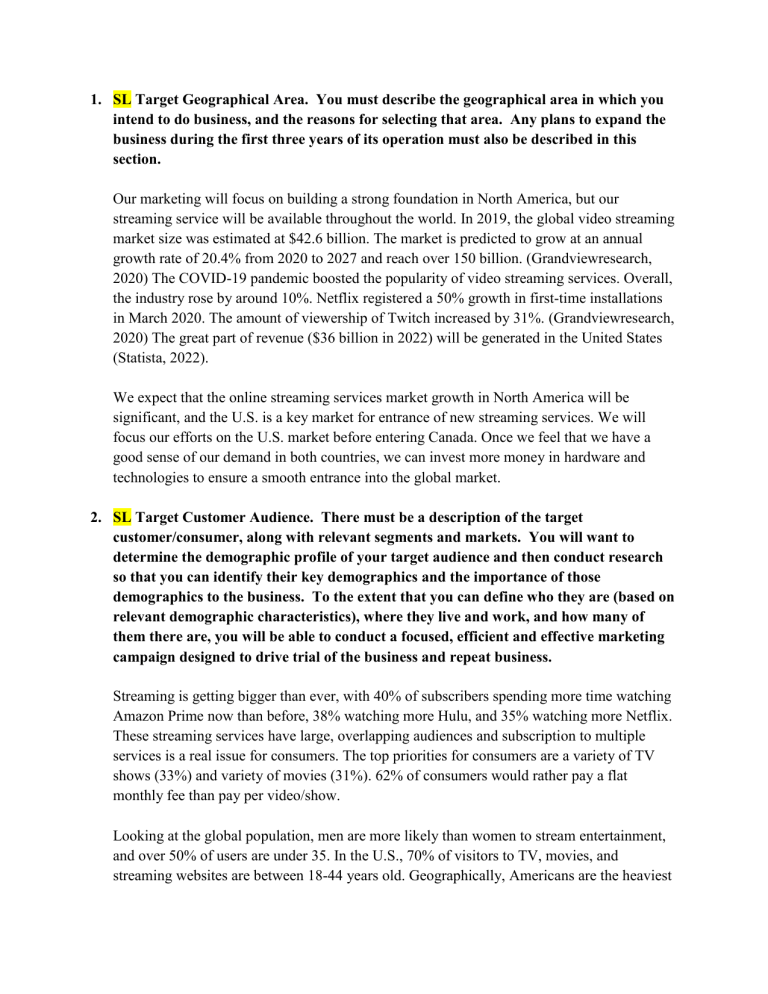
1. SL Target Geographical Area. You must describe the geographical area in which you intend to do business, and the reasons for selecting that area. Any plans to expand the business during the first three years of its operation must also be described in this section. Our marketing will focus on building a strong foundation in North America, but our streaming service will be available throughout the world. In 2019, the global video streaming market size was estimated at $42.6 billion. The market is predicted to grow at an annual growth rate of 20.4% from 2020 to 2027 and reach over 150 billion. (Grandviewresearch, 2020) The COVID-19 pandemic boosted the popularity of video streaming services. Overall, the industry rose by around 10%. Netflix registered a 50% growth in first-time installations in March 2020. The amount of viewership of Twitch increased by 31%. (Grandviewresearch, 2020) The great part of revenue ($36 billion in 2022) will be generated in the United States (Statista, 2022). We expect that the online streaming services market growth in North America will be significant, and the U.S. is a key market for entrance of new streaming services. We will focus our efforts on the U.S. market before entering Canada. Once we feel that we have a good sense of our demand in both countries, we can invest more money in hardware and technologies to ensure a smooth entrance into the global market. 2. SL Target Customer Audience. There must be a description of the target customer/consumer, along with relevant segments and markets. You will want to determine the demographic profile of your target audience and then conduct research so that you can identify their key demographics and the importance of those demographics to the business. To the extent that you can define who they are (based on relevant demographic characteristics), where they live and work, and how many of them there are, you will be able to conduct a focused, efficient and effective marketing campaign designed to drive trial of the business and repeat business. Streaming is getting bigger than ever, with 40% of subscribers spending more time watching Amazon Prime now than before, 38% watching more Hulu, and 35% watching more Netflix. These streaming services have large, overlapping audiences and subscription to multiple services is a real issue for consumers. The top priorities for consumers are a variety of TV shows (33%) and variety of movies (31%). 62% of consumers would rather pay a flat monthly fee than pay per video/show. Looking at the global population, men are more likely than women to stream entertainment, and over 50% of users are under 35. In the U.S., 70% of visitors to TV, movies, and streaming websites are between 18-44 years old. Geographically, Americans are the heaviest users of online streaming services with 20.2% traffic share compared to Russia following with 5.1% traffic share. Understanding the target audience is easier when looking first to Netflix’s subscribers. Streaming is synonymous with Netflix, and a typical subscribe to the world’s most popular streaming platform is a millennial who earns less than $50,000 a year according to US data prepared by Morning Consult Brand Intelligence. 68% of Netflix subscribers have some or no college education and about 33% have at least a bachelor’s degree. They tend to live in the suburbs and politically identify as either a liberal or moderate. Our target audience will be similar to a typical Netflix subscriber, with the main points of differentiation being cost and variety. Netflix’s cost has risen and its subscribers have fallen in 2022 due to increasing subscription prices. Stream House aims to provide that low-cost option while retaining the level of variety that a larger, more expensive streaming service might have. Cost, ease-of-use, and variety are essential components for running a successful streaming service, and they are the primary driving factors for our target customer audience. 3. SL Strategy Canvas. Based on your analysis of the target customer audience, your competition and the key factors of competition in your industry, you will need to identify the key points of differentiation that will drive your strategy in the operation of the business. Your Strategy Canvases should be included as an Appendix to the plan. Concurrently we will be building a SWOT analysis to help craft your strategy. Strengths – content variety, ease-of-use, multiple subscription models Stream House’s strengths include content variety, ease-of-use, and multiple subscription models. The 5 different groupings offered by Stream House aim to provide consumers with a wide variety of content based on personal preferences. Niche offerings look to attract users from around the globe, while keeping affordability has a main point of differentiation. Switching between different platforms is an inconvenience for families and ease-of-use is a major point of differentiation for Stream House. Despite all of our different offerings, we will have them on one platform that will allow consumers to search by rating, genre and more. The multiple subscription models will also aid in providing an intersection between content variety and ease-of-use. Consumers can focus on their specific interests and add on packages as they see fit. Weaknesses – original content, limited copyrights, dependency on North America market Stream House will lack original content initially which will be a retention issue with consumers as we could be priced out if the same content is available with a larger company with more original content. Limited copyrights will also be an issue because certain studios may not want to provide copyrights to their movies since there are multiple streaming services with those licenses. Confirming licenses will be one of the initial roadblocks for Stream House. We will also rely heavily on the North American market for its revenue, while opening in different markets may be more fruitful. Overdependence on this market can lose us some competitive edge. Opportunities – expansion into international markets, additional subscription models Stream House has a huge opportunity for entrance into international markets, especially with niche sports like F1 and Indian Premier League. Being able to show those sports for a much cheaper price than Disney’s Hotstar and ESPN+ packages will be huge for countries outside of the United States. Some of the Netflix’s content is geographically restricted, and getting into those markets with the movies that are unavailable in those countries is an excellent opportunity. Adding additional subscription models for international shows/movies, by language and more is another opportunity to explore. Combining packages based on available and future data collection can prove to reduce cost while providing more content variety. Threats – piracy, cybercrime, competition The main threat faced by a streaming company is piracy. Movies and TV shows are widely available on illegal websites, which can prevent people from signing up or leaving the streaming service after a trial. Cybercrime is becoming a larger issue with hacking threats and leaks of personal information. Consumers may choose to leave streaming services and minimize the amount of personal information that is out there to alleviate some of those concerns. Entire companies and organizations can be shut down if hackers gain access to internal systems. Finally, competition is a significant factor within streaming services because of the emergence of multiple streaming platforms. In order to succeed, Stream House will need to differentiate from Netflix, Disney, Paramount+, Peacock, etc. Entering international markets can be quite hard as well with other competitors in those arenas.

